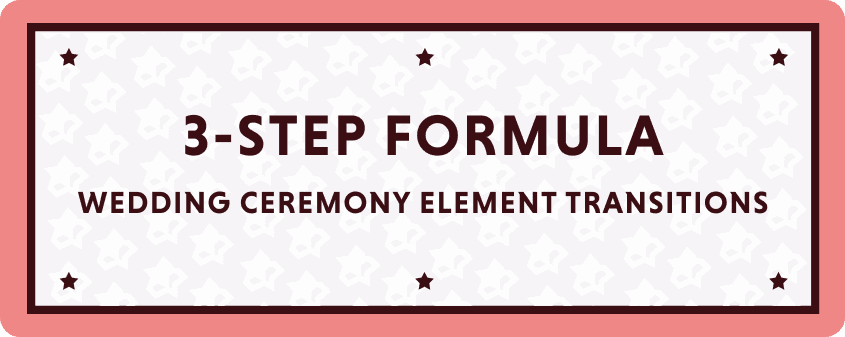Wedding officiants have one major concern when writing the ceremony: “What do I say?”
And it’s not just the speech or the vows or other ceremony elements. Officiants just like you are worried about how to flow from one part of the ceremony to the next.
This comes from our tendency to think of the ceremony as a brick wall. The elements are the building blocks, and then… But don’t those blocks need mortar between them? If there’s nothing holding it all together, the whole thing falls apart, right?
Actually, no. And that’s good news for us officiants.
Teleporting Through the Ceremony
A ceremony is more like a linear hyperspace experience where you teleport from place to place. Fussing over transitions is like obsessing over openings between rooms in your house.
(Okay, I know we’ve gone from a brick analogy to a hyperspace analogy to a doorway analogy, but bear with me…)
Here’s what I mean:
As Master of Ceremony, the officiant creates the reality of what is happening in the ceremony at any given time.
So, you don’t need to get overly flowery or poetic, preparing people for what is about to happen. In fact, a lot of guests will consider this a waste of time. They might not be able to put their finger on it, but they’ll subconsciously detect you’re using “busymaking” language.
Instead, when you finish one element, just lead your couple and their guests into the next part of the ceremony. Just…. “teleport.” Walk on through!
Suddenly, you’re all there in the new space, doing the next thing. No unnecessary fluff or window dressing. Because you, the officiant, said so.
I’ve always been direct and to the point when it comes to everything that happens in the wedding ceremony. It’s one of the reasons that trained Unboring!Wedding officiants and I get such rave reviews.
How do we seamlessly move between wedding ceremony elements? I teach a simple 3-point formula that takes the headache out of writing any wedding ceremony element. It means your elements will be clear, and you won’t need anything “between” them.

The Unboring!Wedding 3-Step Formula for Wedding Ceremony Element Transitions
1. Write Headings for Each Ceremony Element In Your Wedding Ceremony Script
Whether it’s vows, rings, readings, unity shots, or whatever else your couple wants to add, the goal of a well-written wedding ceremony script is for every section to be labeled with an easy-to-read heading in bold font. And you can do this before the elements are fleshed out at all. At first, you’re just outlining the major events of the ceremony. This is the first step in crafting your script. (My wedding script protip is to build it in Google Docs. Here’s why.)
Your clear wedding script headings accomplish two things.
First, headings make it clear to you what you’re creating as you write the ceremony and what you’re doing as you perform the ceremony.
You’re less likely to wander during writing when you look up, see your heading, and use that as a guide for what you should be saying when you write this part of the ceremony.
Second, a clear heading and a clear script will help make sure your listeners never get lost during the ceremony. They’ll always know where you’ve been, where you’re going, and what you’re doing.
As officiants, we have the benefit of reading our script and seeing the big bold headings that mark off the sections of our script.
But listeners to your ceremony don’t have that benefit. They’re not reading along. This means the way you introduce each section and what you decide to say about it need to keep the couple and their guests oriented during whatever element you’re performing now.
That’s where headings in our script help. As you’re writing, you won’t wander off talking about readings when your heading is “Handfasting.” You’ll stay dialled into handfasting as you write; when you perform this part, your listeners will know this is the handfasting section of the ceremony as you perform.
We don’t want to actually read the headings aloud, though. It would be jarring and interrupt the flow if we loudly declared “exchange of rings!” when we get to the heading in our script that says, “Exchange of Rings.”
Orienting your listeners is one of the keys to keeping their attention. But orienting them without sounding like you’re glued to the page is an art, here’s how you do that.
This leads us to the next two points on the execution. Which of the two you do first is up to you, but you do need to incorporate both as part of the formula.
2. Introduce the Element By Name
When you get to any element in your ceremony script, the first thing you can do is simply introduce the element by name.
To put it another way: state what we’re doing now.
Here’s what that looks like. Say we’re at the part of the ceremony where our couple will exchange their wedding vows. It’s clearly marked in our script with the bold heading “Exchange of Wedding Vows.”
The officiant can come into that section with, “Ashley and Sam will now make promises to each other that in this traditional setting, we call ‘wedding vows’.”
You don’t need to be any more elaborate than that. You’ve introduced the section, and all the listeners are fully oriented and aware that we’re entering that section of the ceremony. It’s as good as having a wedding ceremony program in their hands! (These are becoming rarer and rarer. Another reason for the officiant to be clear about the sections.)
So when we get to the section on wedding vows, the officiant would simply cover the “what” aspect of this section by simply stating, “Ashley and Sam will now exchange wedding vows. They have chosen to write their own personal wedding vows, and so Sam, I invite you to read yours first.”
But that ingredient on its own is not quite enough. Which is why it needs to be paired with… the why.
3. Explain The Significance of Each Element
This step can otherwise be very eloquently called, “Why?” Why are we doing the element we’re doing now?
The answer – and this is what you can write – can be as simple as what makes this element significant in the ceremony and/or their relationship. And then you can go from there into what this element or ritual means.
This is important if the element has a symbolic meaning that needs to be explained, like a quiach or handfasting for instance. They signify specific things, like an analogy, and we want to make sure everyone understands what it’s standing for.
So when it comes time for wedding vows, the officiant can say,
“This is the heart of the ceremony – the part of the day and their story when Ashley and Sam break new ground into their relationship and deepen their bond like never before.”
Do you see what we did there? We explained why this next part is so significant, not just for our couple’s ceremony but for their lives.
For a unity ritual, it would need to be longer than that, but it follows the same rubric.
Take handfasting, for example. We would want to start with the “why” of the ritual. Then move into the “what”. Then, we can even move back into the “why” for even more context.
“Symbols are important and helpful. A symbol is important because it makes an idea concrete and physical. It becomes something we can see and touch. Symbols are helpful because they serve as a powerful reminder of a time, a place, or a memory that may have faded over time. Handfasting is a symbol like this. It’s one of the world’s oldest wedding traditions and it’s found in cultures all over the world.
Ashley and Sam would like to observe this ritual of handfasting today, to symbolize how they freely offer their lives to one another. In fastening their hands together, the ribbon symbolizes how Ashley and Sam leave this place with lives now bound up together with two sets of hopes and desires for the future joined in commitment and intention.”
Can you see how we went from the “why” to the “what” and back to the “why?” These are the only two real ingredients you need for any wedding ceremony element.
This is why 1) clear headings, 2) “the what,” and 3) “the why” are the perfect 3-point formula for getting from one element to the next in a wedding ceremony.
Let’s look at an example.
The 3-Point formula in Action
Here’s how a wedding ceremony script might look for wedding vows and then a handfasting.
Exchange of Wedding Vows
“This is the heart of the ceremony, the part of the day and their story when Ashley and Sam break new ground in their relationship and deepen their bond like never before. Ashley and Sam will now exchange wedding vows. They have chosen to write their own personal wedding vows, and so Sam, I invite you to read yours first.”
Handfasting
“Symbols are important and helpful. A symbol is important because it makes an idea concrete and physical. It becomes something we can see and touch. Symbols are helpful because they serve as a powerful reminder of a time, a place, or a memory that may have faded over time. Handfasting is a symbol like this. It’s one of the world’s oldest wedding traditions and it’s found in cultures all over the world.
Ashley and Sam would like to observe this ritual of handfasting today, to symbolize how they freely offer their lives to one another. In fastening their hands together, the ribbon symbolizes how Ashley and Sam leave this place with lives now bound up together as two sets of hopes and desires for the future joined in commitment and intention.”
Stop Transitioning and Start Teleporting
Don’t overthink transitions or waste time dreaming up things to say “in between”. Just deploy the 3-point formula for every wedding ceremony element – the marriers and their guests will thank you.
If you’re a first-time wedding officiant, you might want to read my guide to officiating your first ceremony.

